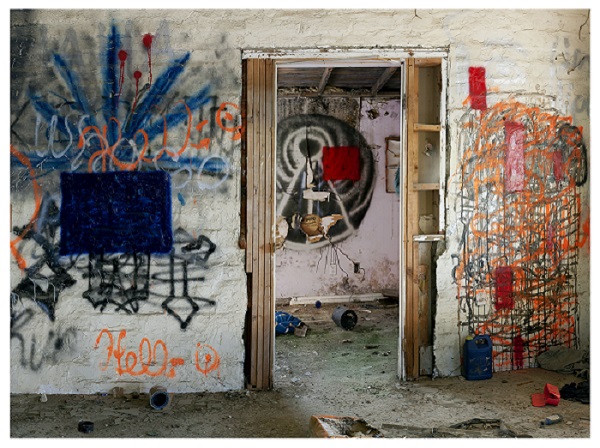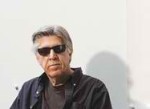
John Divola
American, 1949-
Theodore Street Series, 2012-
Pigment print
40 x 54"
Courtesy of the Artist

“Structure is a static concept of a process frozen in the specious present” - Arthur Koestler
COMMENTS
What brought him to Riverside? Partly, perhaps, the same qualities that he cites for choosing the studio: “Being here is a practical consideration—it’s very inexpensive, convenient, clean, and air conditioned.” I point out that the area is not dissimilar to the San Fernando Valley, which he documented in an eponymous series of photographs from 1971–73, made at the outset of his career. In those images, I suggest, there was a sense of sociopolitical criticality, of the photographer’s estrangement from the outwardly conventional suburban environment in which he had grown up.
“That’s a misinterpretation,” he says. “Even though I was to some extent alienated, especially by the war in Vietnam, I never had a desire to get away from it. It was what I was. And actually, one of the reasons my work changed after that was that your reading of that work was everybody’s reading of that work—that it was critical. It wasn’t. That was my landscape, and I was moving through that landscape, and I wanted to bring back an index of my engagement with it.”
This widespread misreading of Divola’s position as an artist has dogged him throughout his career, and it has to a great extent shaped his subsequent work. Putting himself in the picture, implicating himself in the situations that he photographs, is for him a central strategy. After the San Fernando Valley series he made Vandalism (1973–75), black-and-white images of derelict houses featuring spray-painted marks that, it becomes clear, were made by Divola himself. He is the vandal—or one of them.
Divola’s Dark Star series, from 2008, was shot largely in an empty house fifteen miles inland from Riverside, at the eastern edge of the megalopolis that stretches all the way to the Pacific Ocean. Large discs of black spray paint recollect the mysterious markings he had made in Vandalism.
In the same house, Divola made the more recent series Theodore Street (2008–12) using an ultra-high-resolution method of photography called Gigapan. Between 40 and 120 separate photographs are stitched together by software to make a picture that can be printed at large scale without losing detail. Divola says his early prints are small only because, printed any larger, the raw materiality of his subject—scraps of plywood, shattered glass—would have been overwhelmed by the grain and fuzz of the photograph. In prints up to five by ten feet, some of which will be shown in Santa Barbara, Divola physically enters the scene and secretes himself among the details. There is plenty of space for the artist to get lost.
Jonathan Griffin, "John Divola at his Riverside Workplace," Aperture Magazine
#211, Summer 2013
http://www.aperture.org/blog/john-divola-at-his-riverside-workplace/
SBMA CURATORIAL LABELS
In 2007 I began using an 8x10 view camera to photograph painted interventions in abandoned structures. This activity culminated in two photographic projects that I later titled Interventions and Dark Star. Several of these images from both projects were photographed in a structure located at 11376 Theodore Street in Moreno Valley, California. When, after making some of the photographs for these two bodies of work, I later returned to Theodore Street, I found that many subsequent individuals had acted and painted in the space.
In 2008 I started experimenting with a robotic camera mount, called a gigapan. One mounts a digital camera on the device, programs the field of view, and starts the device. The gigapan precisely scans the scene producing overlapping exposures. In my case there are anywhere from 70 to 120 images made over 15 to 20 minute time frame. These images are subsequently merged together using stitching software producing what appears to be a single seamless panorama.
From 2009 to 2012 I returned on multiple occasions to the Theodore Street house to make gigapan scans of the interior. Generally, in these images, there is an act or presence which functions as a temporal marker within the interval of the scan. I am that presence in these gigapan scans, both implied and literal. I last visited the location a few months ago to find that the structure had been demolished.
Any abandoned house is inscribed with a dialog of its era, inscribed with a history. It is a locus of activity, change, and entropy. Any photograph is an impression of one specific place on earth at one specific, to quote Koestler, “specious present.”
- John Divola, As Far As I Could Get, 2013
